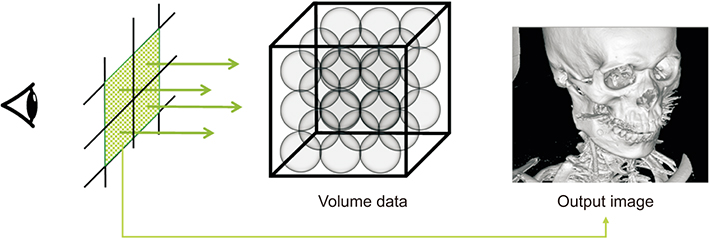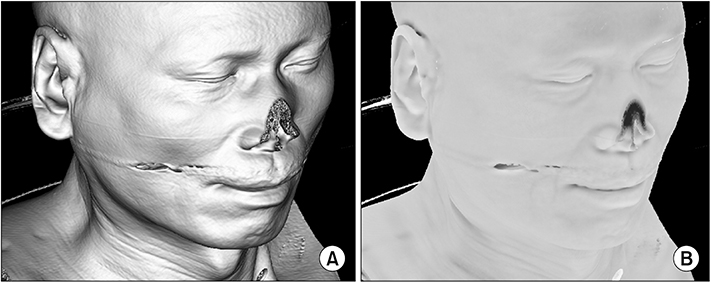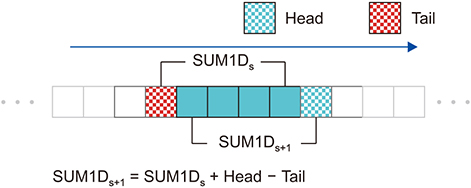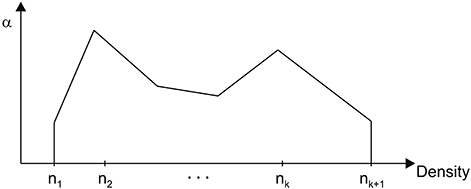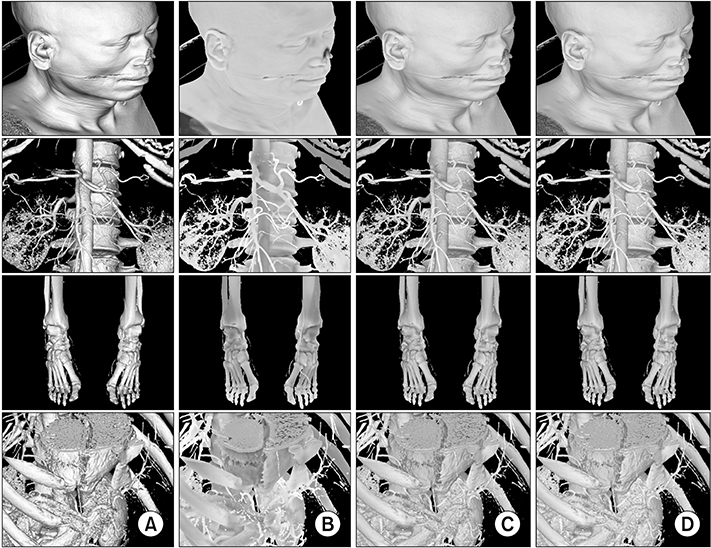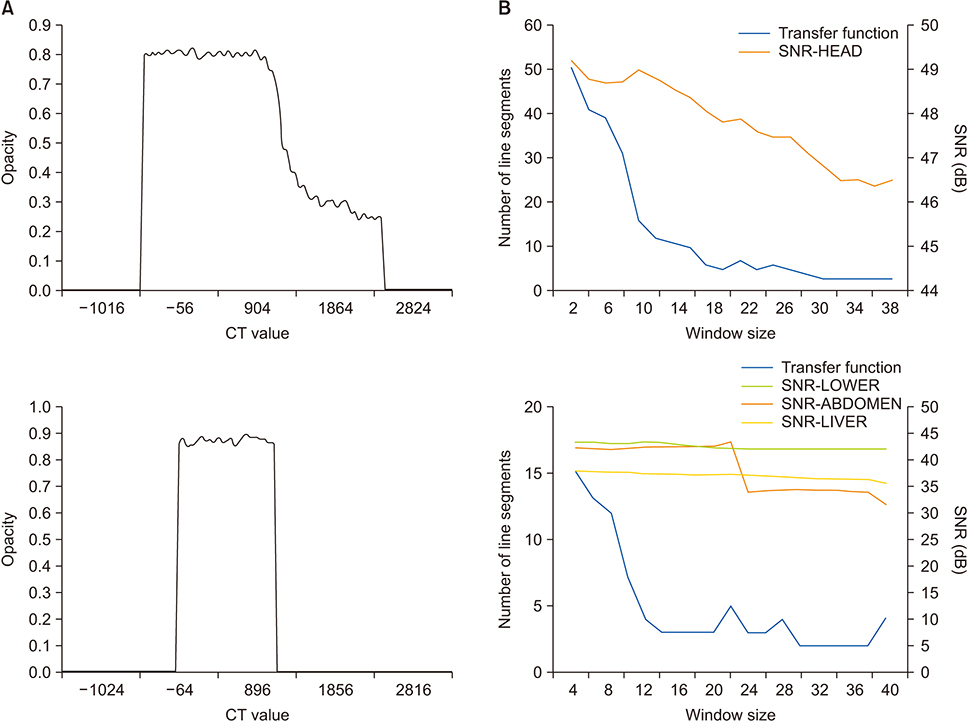Healthc Inform Res.
2019 Oct;25(4):297-304. 10.4258/hir.2019.25.4.297.
Real-Time Computed Tomography Volume Visualization with Ambient Occlusion of Hand-Drawn Transfer Function Using Local Vicinity Statistic
- Affiliations
-
- 1Division of Computer Engineering, Hansung University, Seoul, Korea. kuei@hansung.ac.kr
- KMID: 2462228
- DOI: http://doi.org/10.4258/hir.2019.25.4.297
Abstract
OBJECTIVES
In this paper, we present an efficient method to visualize computed tomography (CT) datasets using ambient occlusion, which is a global illumination technique that adds depth cues to the output image. We can change the transfer function (TF) for volume rendering and generate output images in real time.
METHODS
In preprocessing, the mean and standard deviation of each local vicinity are calculated. During rendering, the ambient light intensity is calculated. The calculation is accelerated on the assumption that the CT value of the local vicinity of each point follows the normal distribution. We approximate complex TF forms with a smaller number of connected line segments to achieve additional acceleration. Ambient occlusion is combined with the existing local illumination technique to produce images with depth in real time.
RESULTS
We tested the proposed method on various CT datasets using hand-drawn TFs. The proposed method enabled real-time rendering that was approximately 40 times faster than the previous method. As a result of comparing the output image quality with that of the conventional method, the average signal-to-noise ratio was approximately 40 dB, and the image quality did not significantly deteriorate.
CONCLUSIONS
When rendering CT images with various TFs, the proposed method generated depth-sensing images in real time.
MeSH Terms
Figure
Reference
-
1. Levoy M. Display of surfaces from volume data. IEEE Comput Graph Appl. 1988; 8(3):29–37.
Article2. Engel K, Hadwiger M, Kniss JM, Rezk-Salama C, Weiskopf D. Real-time volume graphics. Wellesley (MA): AK Peters Ltd.;2006.3. Kruger J, Westermann R. Acceleration techniques for GPU-based volume rendering. In : Proceedings of the 14th IEEE Visualization; 2003 Oct 22–24; Seattle, WA:4. Levoy M. Efficient ray tracing of volume data. ACM Trans Graph. 1990; 9(3):245–261.
Article5. Cai LL, Nguyen NP, Chui CK, Ong SH. Rule-enhanced transfer function generation for medical volume visualization. Comput Graph Forum. 2015; 34(3):121–130.
Article6. Phong BT. Illumination for computer generated pictures. Commun ACM. 1975; 18(6):311–317.
Article7. Nelson B, Kirby RM, Haimes R. GPU-based volume visualization from high-order finite element fields. IEEE Trans Vis Comput Graph. 2014; 20(1):70–83.
Article8. Berger M, Li J, Levine JA. A Generative Model for Volume Rendering. IEEE Trans Vis Comput Graph. 2019; 25(4):1636–1650.
Article9. Kroes T, Schut D, Eisemann E. Smooth probabilistic ambient occlusion for volume rendering. In : Engel W, editor. GPU pro 360 guide to GPGPU. Boca Raton (FL): CRC Press;2019. p. 305–316.10. Ropinski T, Meyer-Spradow J, Diepenbrock S, Mensmann J, Hinrichs K. Interactive volume rendering with dynamic ambient occlusion and color bleeding. Comput Graph Forum. 2008; 27(2):567–576.
Article11. Hernell F, Ljung P, Ynnerman A. Local ambient occlusion in direct volume rendering. IEEE Trans Vis Comput Graph. 2010; 16(4):548–559.
Article12. Diaz J, Yela Reneses H, Vazquez Alcocer PP. Vicinity occlusion maps: enhanced depth perception of volumetric models. In : Proceedings of the Computer Graphics International Conference; 2008 Jun 9–11; Istanbul, Turkey. p. 56–63.13. Staib J, Grottel S, Gumhold S. Visualization of particle-based data with transparency and ambient occlusion. Comput Graph Forum. 2015; 34(3):151–160.
Article14. Nam J, Kye H. Fast ambient occlusion volume rendering using local statistics. J Korea Multimed Soci. 2015; 18(2):158–167.
Article15. Maciejewski R, Jang Y, Woo I, Janicke H, Gaither KP, Ebert DS. Abstracting attribute space for transfer function exploration and design. IEEE Trans Vis Comput Graph. 2013; 19(1):94–107.
Article16. Srivastava V, Chebrolu U, Mueller K. Interactive transfer function modification for volume rendering using compressed sample runs. In : Proceedings of the Computer Graphics International Conference; 2003 Jul 9–11; Tokyo, Japan. p. 8–13.17. Pfister H, Lorensen B, Bajaj C, Kindlmann G, Schroeder W, Avila LS, et al. The transfer function bake-off. IEEE Comput Graph Appl. 2001; 21(3):16–22.
Article18. Ropinski T, Praßni JS, Steinicke F, Hinrichs KH. Stroke-based transfer function design. In : Proceedings of the Eurographics/IEEE VGC Workshop on Volume Graphics; 2008 Aug 10–11; Los Angeles, CA. p. 41–48.19. Hadwiger M, Kratz A, Sigg C, Buhler K. GPU-accelerated deep shadow maps for direct volume rendering. In : Proceedings of the 21st ACM SIGGRAPH/EUROGRAPHICS Symposium on Graphics Hardware; 2006 Sep 3–4; Vienna, Austria. p. 49–52.20. Marsalek L, Hauber A, Slusalled P. High-speed volume ray casting with CUDA. In : Proceedings of IEEE Symposium Interactive Ray Tracing; 2008 Aug 9–10; Los Angeles, CA.
- Full Text Links
- Actions
-
Cited
- CITED
-
- Close
- Share
- Similar articles
-
- The Usefulness of Three-dimensional Computed Tomography as an Assessment of Periacetabular Osteolysis in Revision Total Hip Arthroplasty
- Computed Tomography Analysis of The Distal Radioulnar Joing
- MDCT Application of Thoracic Imaging
- Real-Time Visualization of Thrombus during Suction Thrombectomy : Contrast-in-Stasis Technique
- Nerve Transfer to Restore Upper Extremity Function

